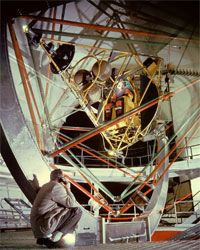Astronaut Training
Applicants accepted as astronaut candidates report to Houston, Texas, the site of NASA's primary astronaut training facility. Known today as the Johnson Space Center (JSC), the facility actually began in 1961 as the Manned Spacecraft Center. In 1973, its name was changed to honor former president and Texas native Lyndon B. Johnson, who died that January. The JSC played a pivotal role in the Gemini, Apollo, Skylab, space shuttle and International Space Station programs. Over its nearly 50-year history, JSC has trained more than 300 U.S. astronauts and 50 astronauts from other countries. The training process used today is the culmination of this considerable experience.
The first phase starts with two years of basic training. Much of this training takes place in the classroom, where astronaut candidates learn about vehicle and space station systems. They also study key disciplines -- including earth sciences, meteorology, space science and engineering -- that may prove helpful in their work in space. Outside the classroom, astronaut candidates must complete military water- and land-survival training to prepare for an unplanned landing back on Earth. This survival training requires that they become scuba qualified and pass a swimming test in their first month. They must swim three lengths of a 25-meter (82-foot) pool without stopping, and then swim three lengths of the pool in a flight suit and tennis shoes with no time limit. They must also tread water continuously for 10 minutes while wearing a flight suit.
Advertisement
Once the basic training period is complete, candidates may be selected to become astronauts. You might think this is the end of training, but it's really just the beginning of the second phase. In this phase, astronaut trainees are grouped with experienced astronauts, who serve as mentors to share knowledge and experience. The ultimate goal of this mentoring relationship is to make sure each trainee is proficient in all activities related to pre-launch, launch, orbit, entry and landing.
Finally, astronauts receive their mission and crew assignments, entering what is known as the advanced mission training phase. In this final 10-month training period, astronauts focus on activities, exercises and experiments specific to their mission. For example, astronauts assigned to the STS-61 mission (Space Shuttle Endeavor, December 1993) were tasked with fixing the optics of the Hubble Space Telescope. Therefore, their training involved working with a full-sized model of the telescope in the Neutral Buoyancy Simulator at the Marshall Space Flight Center in Huntsville, Ala. The crew also trained at the Goddard Space Flight Center in Greenbelt, Md., where they familiarized themselves with the power tools and other special devices they would use during the mission.
As the STS-61 mission clearly demonstrates, a variety of simulators and facilities are needed to prepare astronauts for their work in space. JSC operates another neutral buoyancy simulator -- the Neutral Buoyancy Laboratory, or NBL -- to simulate weightlessness on Earth. The NBL is housed within the Sonny Carter Training Facility and, at 200 feet (61 m) long and 40 feet (12 m) deep, holds 6.2 million gallons (23.5 million liters) of water. Deep within the pool, astronauts train for spacewalks, spending approximately 10 hours under water for every hour they spend walking in space.
Since the end of the U.S. space shuttle program, more and more Americans train at Star City, a cosmonaut training facility near Moscow. Here, space-bound trainees receive hundreds of hours of training to help them tackle both routine procedures and surprise circumstances so that they can operate the Soyuz craft in any situation.
The variety of challenges faced by astronauts requires many different training environments. Learn more on the next page.
